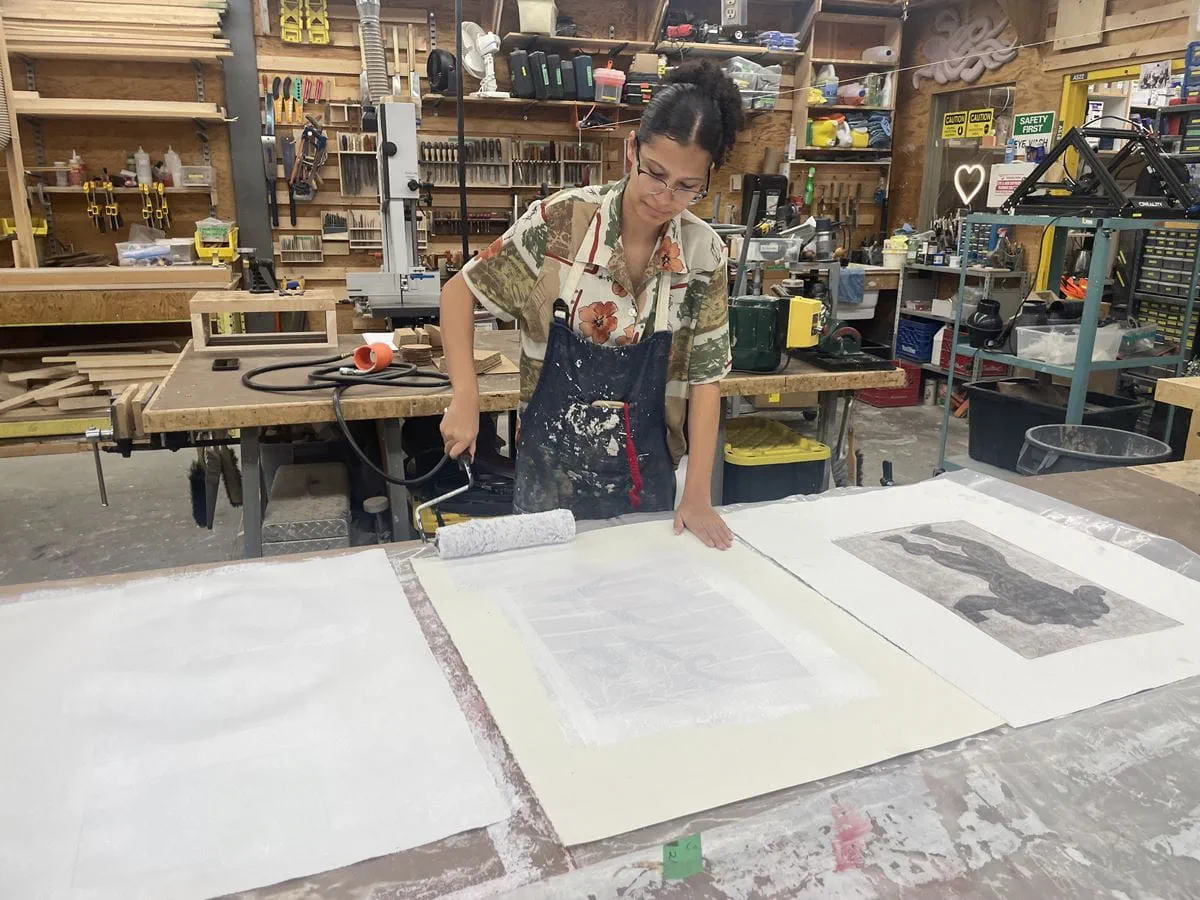
Sustainability meets innovation in Sheridan’s art studios
 by Teresa Baerg – Apr 4, 2025
by Teresa Baerg – Apr 4, 2025 Sheridan’s Art and Art History programs are finding innovative ways of infusing sustainability into the painting, drawing and sculpture studios.
And they’re doing more than just reducing, reusing and recycling: they’re finding ways to repurpose and make new art from old art, giving second lives to all kinds of art materials.
Stephen Mazza is the Art and Art History Program Technologist in the Faculty of Animation, Arts & Design, working in the Annie Smith Building at Trafalgar Road Campus with the program’s sculpture, drawing and painting disciplines. And he’s leading the charge towards more sustainable studios, from creating raw paper from scrapped cardboard, to repriming leftover prints so they can be used again.
“Our goal is to try to give new life to as much of that material as possible by finding ways to reuse it in other classes."
– Stephen Mazza, Art and Art History Program Technologist
Mazza began his foray into making the art studios more sustainable when he became frustrated on a purely logistical level. He saw how much of the raw materials used for student projects ended up as waste once the project was complete. He felt a responsibility to help reduce the environmental footprint.
“While most people understand the importance of sustainability, the challenge has been moving from ideals to implementation,” Mazza says. “In the day to day of work and responsibilities and deadlines, it is an added effort that may not see immediate or obvious results.”
Another deterrent was the mixed reports of the effectiveness of some traditional recycling efforts. Mazza thought finding in-house ways of using and reusing materials would be more efficient than relying on outside services.
Much of Mazza’s efforts involve having conversations with colleagues in other programs to find ways to collaborate on repurposing initiatives or share best practices.

And Mazza has found ways to include students in his sustainability work. Students participating in Sheridan’s Work Study, a program which financially supports full- and part-time students to gain essential work experience, help instructors in the studios. Students such as Martha Burchert, a second-year student in the Art & Art History program (Honours Bachelor of Arts), are learning many of the techniques he is incorporating, and have the chance to contribute their own skills and ideas, both to sustainability initiatives and the regular work of the studio.
"As a painting Work Study student, I gained a new perspective on the inner workings of an art school,” Burchert said. “I enjoyed watching the art process of fellow painters, recycling and priming old canvases, and setting up still lifes and models for classes."
It’s a win-win-win for instructors, students and the program itself.
“Students need the opportunity to experiment and make mistakes to learn from their experience,” Mazza says. “Our goal is to try to give life to as much of that material as possible by finding ways to reuse it in other classes.” A side benefit is that these students can now access free materials while reducing their environmental footprint.
Mazza has come up with several initiatives that incorporate using materials more effectively.
De-streaming waste is one effective way to make an impact. One technique is to prime the surface of leftover prints and drawing assignments that students no longer need, creating a new, blank canvas. The source material comes from leftover prints that were either experiments or tests of their own, or perhaps from multiple copies as a student experimented with colour and process. These pieces may not always be display-worthy in their final state, but they work well for students in the practice stages of their work.
Mazza also takes the scrap cardboard left over from cardboard crafting assignments that are too small or damaged to use again for another class and shreds it to create a paper clay product, or raw paper, that can be cast into different forms. It’s labour intensive and time-consuming work, but more than just reusing the material, the students are discovering ways of bringing new life and purpose to a material that was used up in its original state.

Another initiative Mazza is seeing success with is sharing surplus off-cuts of wood or cardboard from his studio with other studios in the program, who can make use of these smaller pieces in their projects. The Art and Art History and Art Fundamentals programs have similar projects that allow them to pass on unused materials to be used in new ways. Not only does this sharing make use of these previously discarded materials, but there’s an added benefit of creating much needed storage space.

The benefits of each of these sustainability efforts are many, including keeping materials from the landfill, saving students money on materials, teaching the art of finding new purpose for materials through innovative ideas, and creating a sense of mindfulness about the impact that one person can make.
Discover how you can find the artist within you when you study in Sheridan’s Art and Art History and Art Fundamentals programs. Graduates from these programs become practicing artists who exhibit their work in artist-run, public and private galleries, both nationally and internationally, or go on to pursue graduate studies.
Top photo: Second year student Martha Burchert prepares a print, which is no longer needed, to be used by another student, creating less waste in the studio.
Middle photo: The evolution of materials - discarded cardboard is shredded to become a paper clay product that can then be cast into different forms.
Bottom photo: Stephen Mazza shows an off-cut of wood, which are sorted according to their shape and size, and made available to other studios in the art programs.
Media Contact
Meagan Kashty
Manager, Communications and Public Relations
